Interview with Rui Sasaki
Yun:When I was reading your artist statement, your experience of losing memories by virtue of changing locations caught my attention. When you crossed the world to come to the United States from Japan, you said that you experienced sensations of lost memories and nostalgia. I remember that when I arrived in the U.S., I had very raw feelings about myself as a person lacking context in a new society. It might have been because the contexts of political issues like race and gender were different, but beyond that there were aesthetical differences that I could feel in my skin. I could feel a sensory difference in the way I became mute, deaf, and by becoming animal. I believe that "being animal" is not the same as being "other." Being animal is about becoming a complete unity. I did not feel isolated from others, but recognized my body as a sensory organ. It meant being a different species than what I had been. You mentioned that home is a container of memories and nostalgia. I agree with this because I did not have this kind of opening of senses when I moved to France with my family for a year. I was a tourist that had a place and past to go back to. A tour can be a good "memory." We remember all the great moments using the convergence processes of our brains. As for the sensory experiences that occur by shifting location, the senses do not converge on one spot. It is a completely open experience in which the skin dominates the brain as a principal organ, as the events happen on the surface of the body. When we do not have a past or future, we only have the present events on our skin. I think your way of using your body as a field of event is an intriguing artistic practice.
As I was studying site-specific work and planning this project, I could not resist the idea that the mind belongs not only to the body itself, but also to the location that the body belongs to. My project slowly shifted towards understanding mind movements through the body more than the traditional understanding of site-specific work, which is what drew me to your work. You already mentioned many interesting ideas about body and location, but can you discuss further how you understand the body and memory through your work?
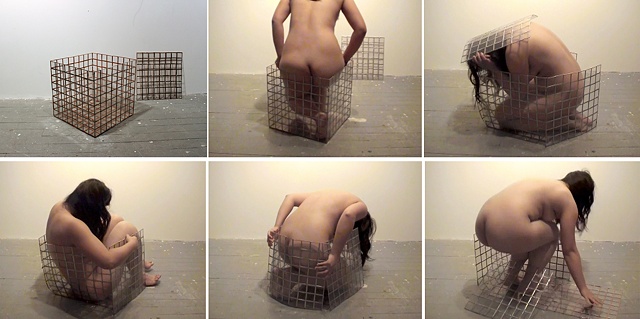 Becoming Square (2010) photo by Matthew Clowney | Rui: The interest of my work is the exploration of intimacy between my body and a space where I am. Nothing is a space itself for me if a space does not contain any connections to me, using my olfactory, visual, auditory, somatosensory, and gustatory senses. The first time I enter a space, I always use these senses to identify whether I am in the safe or the dangerous in a space. Moreover, I feel extremely unconformable and unbelievable (even feel ill towards a space) if a space does not give me subtle intimacy: “Object” or “Space” is just as it is and it cannot talk with me. I am just floating in a space. My understanding of my interest through my work is how intimacy is vital for me to understand where I am. Space can help me identify where I am and who I am. However, I will lose my identity and be confused where I am if a space is totally separated from me: no memory and no intimacy. Therefore, I always try to do my best to know a place and to find something to connect to me with my way, using my body. |
Yun: How can you define you? By tracing? How can you define the
mind? We realize our memories are not as powerful as we believe. We can lose
them by accident. We might find some people who easily lost their intimacy
with their family by losing memories. Your country doesn't have the same
meaning for you after you spend several years in a different nation. But
as the movie Ghost in the Shell shows,
memory might be one of the defining elements of a person. Are you a different
person than before? Or do you need to be different?
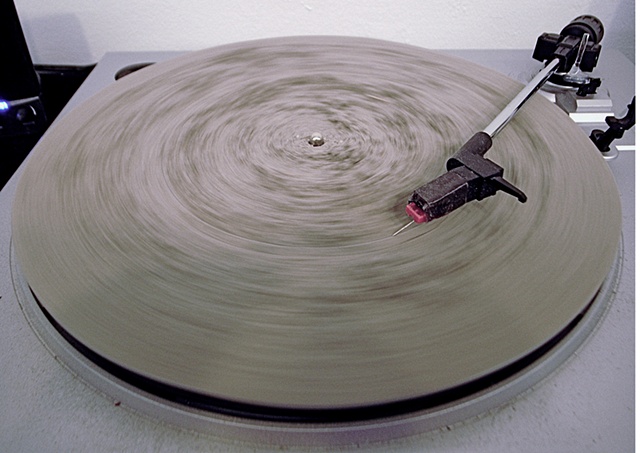 Listen to My Mom (dust record) 2008 | 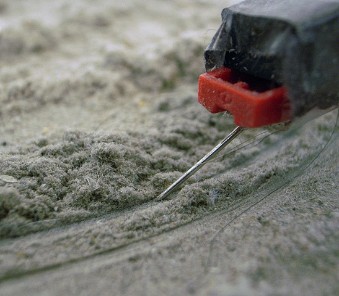 |
Rui: I agree with what you said, that “our memories are not as powerful as we believe. We can lose them by accident.” Have you ever felt extremely isolated? Not just lonely… You actually almost lose yourself and do not know who you are. When an experience has happened, a memory of what once appeared everyday is always under the surface and comes up in your mind. The memory is essential for me to be alive in this world. The memory is the only connection between my body and space. I feel that the memory supports me to be unforgettable to who I am. “Tracing” is one of the ways that I can directly show viewers what I am doing. Moreover, the action of tracing is important for me. I am not interested in what it is and whose tracing it is. The tracing is one of my disciplines to understand and clarify what I want to know. For instance, my butt’s glass cast on a corner is evidence that I cannot touch a corner even though I want to touch it and that I can see how far away from a corner my body is. And, the process of tracing is also my practice to understand the space of the corner using my body. | 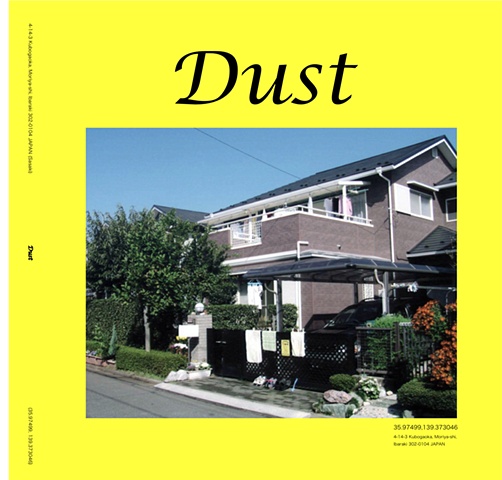 Listen to My Mom (dust jacket: front) 2008 |
As for your second question “Your country doesn't have the same meaning for you …Are you a different person than before?” I think that this is strongly related to my spatial sense. I believe that my memory itself is never changed but my sense, especially for a space, is always fluid. For example, everything in the U.S. is bigger than in Japan. Therefore, my unconscious sense has been altered since I moved to the U.S. Memory is never changed but the feeling of nostalgia is shifted. I feel that everything is small and narrow when I am back in Japan. So, I am confused because I know that here, Japan, is my home. However, the nostalgia is just physical memory. Psychological memory stays forever in my mind.
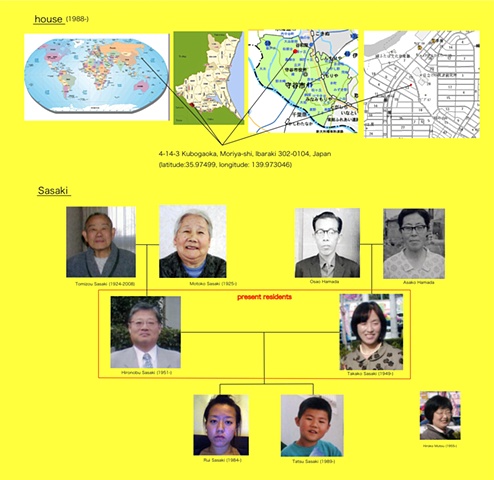 | 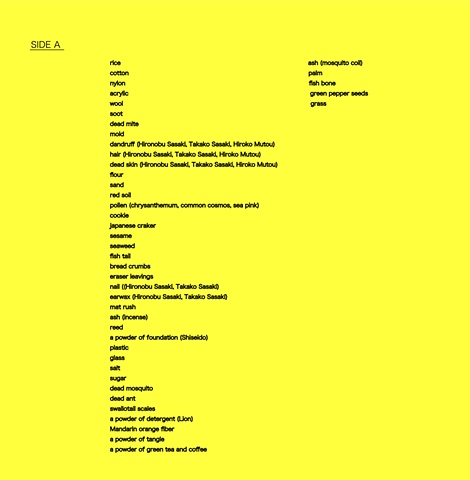 |
Listen to My Mom (dust jacket: content 1,2) |
Yun: Let’s talk more about a memory. I think there are two types of memory attitudes in your work. The first one happens as an object by the presence of your body or/and as a living sense on your body; and the second is a memory that you had, barely hold on to. In the project, Silence (2007), a sound from your mouth doesn’t have value as language and an utterance is lost. So the shape of your mouth to make a specific sound in Japanese became a casted object, like the casting for dead sounds as a language. In Erase (2007), your fingerprint on the window, a way of knowing who you are, turned out to remove your past/memory/identity of the invisibility. And in Listen to My Mom (dust record) (2008), you seem to be trying to turn the dust that you obtained from the house in Japan into a volatile memory by creating a disk. What kinds of sounds were those? Was it for sharing your memories, or for vaporizing the memory you had?
Rui: As for Listen to My Mom (2008), the sounds are surprisingly rhythmic. A needle on a turntable catches each particle of dust and makes rhythm. It is quietly calm and sounds like background music that you can often hear in movies when something starts happening. The sounds constantly change because the dust from Japan mixes in the air and other dust from viewers and the installation space accumulates on the record. In general, dust is mutable and ephemeral. For me, dust is not representative with volatilization. Dust is more stable and permanent. Dust has all the physical elements of my parents’ house in Japan. I wanted to go back to Japan but I could not at that time. So, I was eager to move everything from my house to the U.S. It is impossible, as you know. I believe that dust from Japan contains everything from there. And, it is portable. I can move it to the U.S. in my bag. Moreover, in science, dust is the smallest particle and never changes character as itself. Memories are more psychological issues, as when you said “memory” in your question. I do not use dust as memory. I used dust in the work as physical material. I could not be satisfied with just feeling something through my memories. I really needed to touch something as physical. That was “DUST” for me.
09/15/2011
Artist Statement
…The uncanny is associated with the bringing to light of what was hidden and secret, distinguishing the uncanny from the simply fearful by defining it as that class of the terrifying which leads us back to something long known to us, once very familiar.
— Sigmund Freud, The Uncanny (1919)
My work is about the exploration and discovery of subtle intimacy in unfamiliar spaces: what I refer to as empty space. In 2007, when I crossed the world to come to the United States from Japan, I experienced sensations of lost memories, nostalgia, and loss of home. I consider physical and psychological space as home. House is a physical shelter but home is psychologically important container, holding memories and nostalgia. Home is the only space where I can feel intimacy. Within the unfamiliar space of the uncanny, I challenge the fissure between what can be known and what is unknowable, and what resists clear delineations of intimacy.
I want to bring attention to the moment when I discover who I am in this world of empty and dead space. Freud said, “It may be true that the uncanny is nothing else than a hidden, familiar thing that has undergone repression and then emerged from it.” In my work, the uncanny becomes an important tool to help me recall my authentic memories from hidden and forgotten ones.
It has now been almost three years since I left Japan to study in the United States. Japan was my home but now I do not feel that term describes the same qualities when I return to my country. How did I lose my intimacy in Japan? I think that this is the context of physical space. Do I need this space to feel home and if so, is there a minimum amount that can be defined? It is this questioning that has led to my artistic explanations of empty and dead space. Moreover, upon what is my intimacy built? Is it my physical home in Japan? If space is immaterial, then what are the elements that are important for me to feel intimacy?
I assume that I will not stay one place for a long time during the rest of my life. I am interested in researching nomads in Mongolia. People who do not have a stable place to live and were my ancestors. I am interested in researching nomadic concepts of intimacy in space and meaning of home. For me, home creates a specific relationship between body and space: a relationship of intimacy and memories. Making work in new environment is vital for me. Wandering is a part of my work to achieve the definition of intimacy in empty space and intimacy without space. Through my work, I document the intimacy and memory of the home. With nomadic movement, the physicality of home is shipped away. I wonder what form my work would take if the corners, basements, and dust were no longer there to represent such ideas.
Biography
Rui Sasaki was born and grew up in a suburb of Tokyo. In 2002, she started studying glass in Industrial, Interior, and Craft Design Department at Musashino Art University in Japan that she did her BFA (2002-2006) and got a certificate of curator in museums. She came to the United States in 2007 and earned a MFA in Glass at Rhode Island School of Design in June 2010. Recently, she is awarded an artist fellowship in Creative Glass Center of America in Wheaton Arts, New Jersey and an artist grant in Vermont Studio Center, Vermont.
She is using glass as her physical and conceptual material. Her main investigation is cast glass in a space but also has started using her body as performance, utilizing video, and photography as a means of documentation using glass. She was in the Artist in Residence (AiR) in Sweden in the summer of 2010 and just finished the AiR for 9 months in Worcester Center for Crafts, Worcester State University, Massachusetts in July 2011.
She has been working with many glass and non-glass artists as artist assistant. She taught at Rhode Island School of Design during her MFA and is currently teaching in Worcester Center for Crafts during her AiR. Her work has been exhibited internationally, such as Japan, Korea, Sweden, Denmark, Australia, and a number of places in the US. She lives and works in Worcester, Massachusetts.
Website: http://rui-sasaki.com/home.html